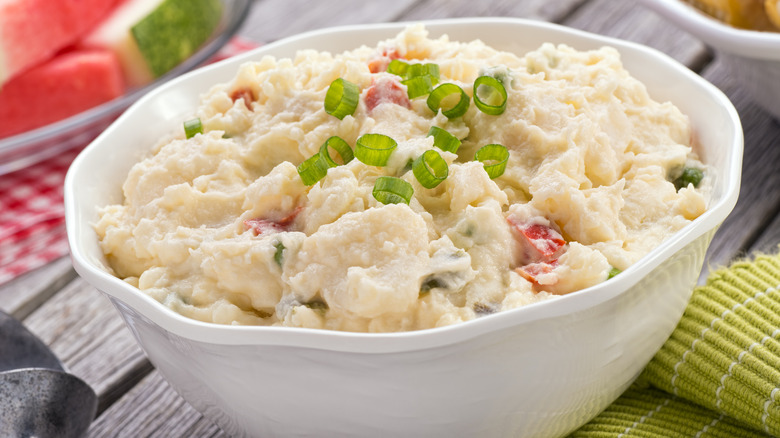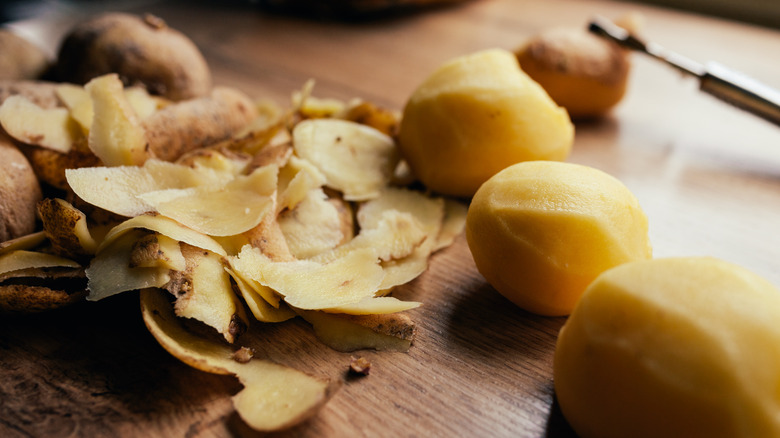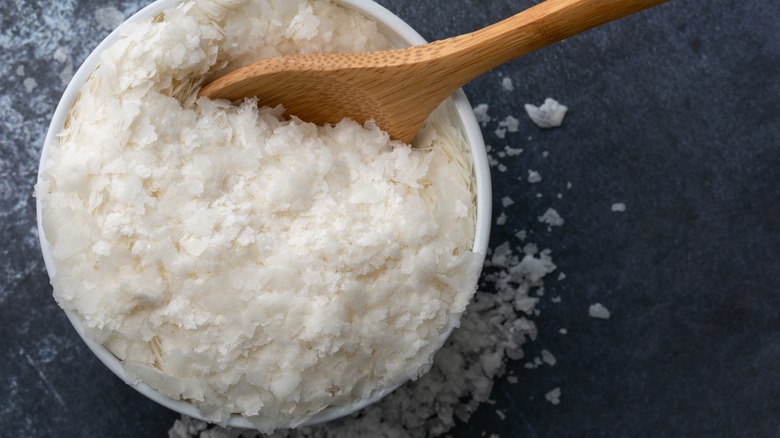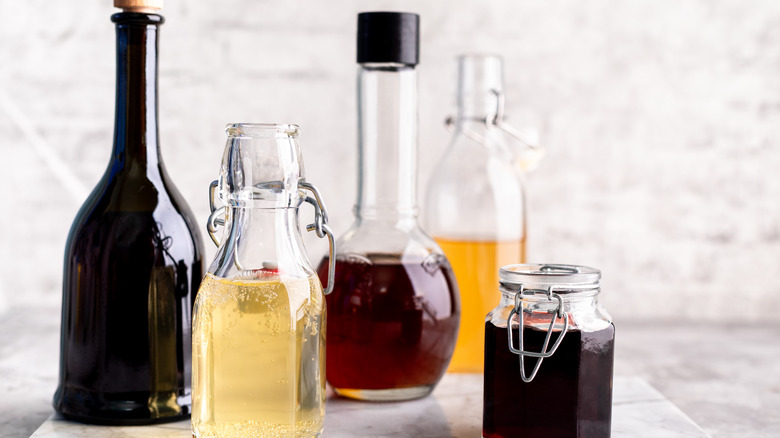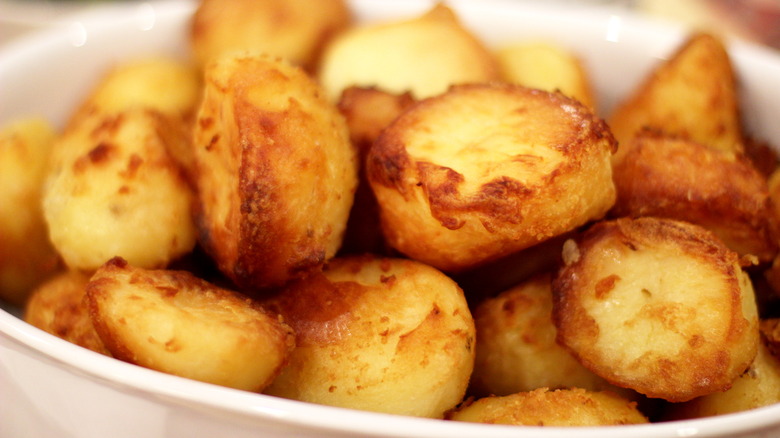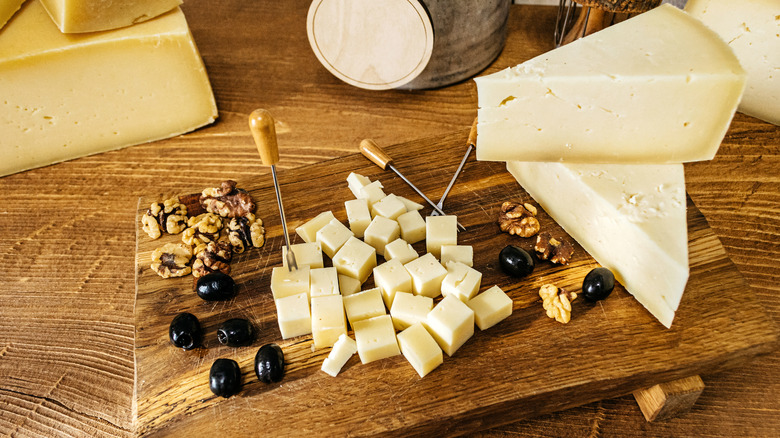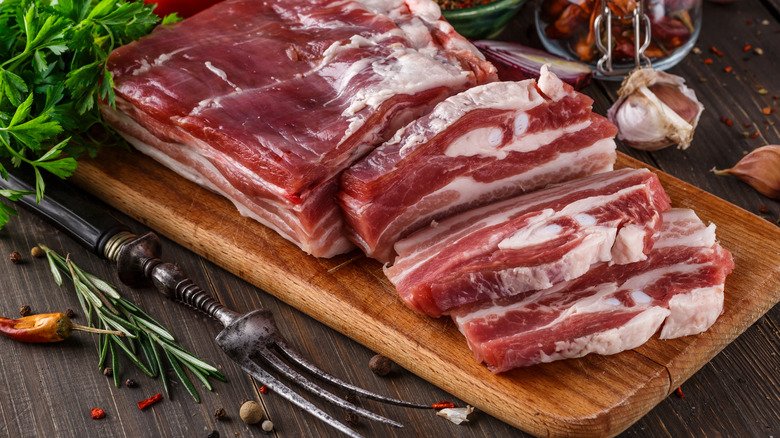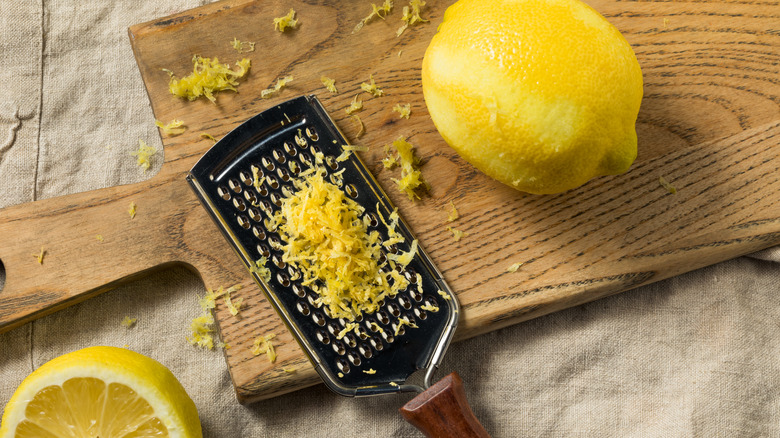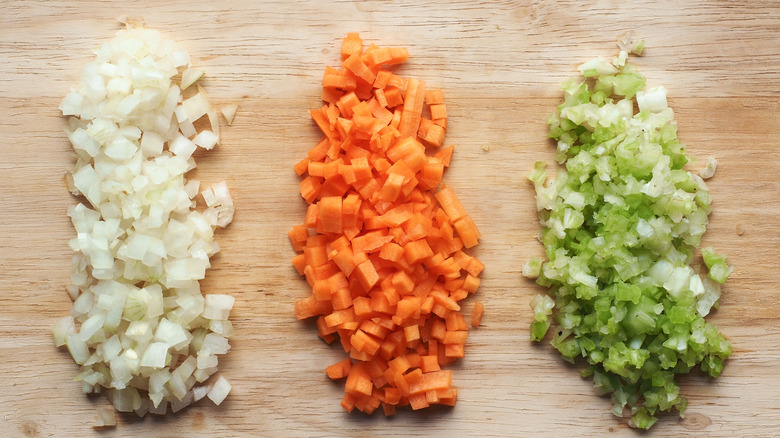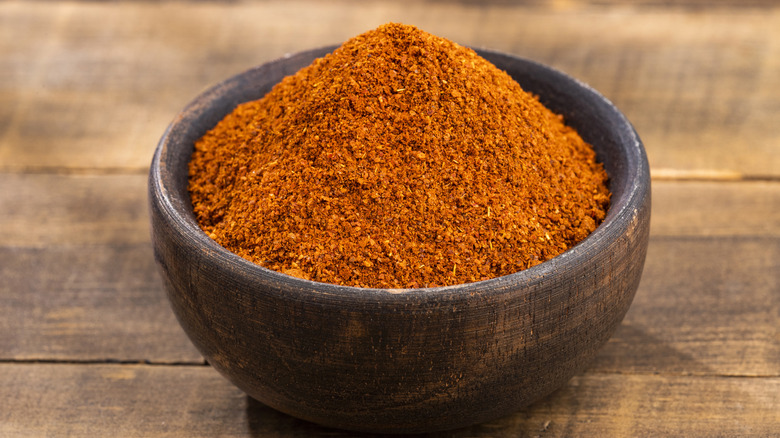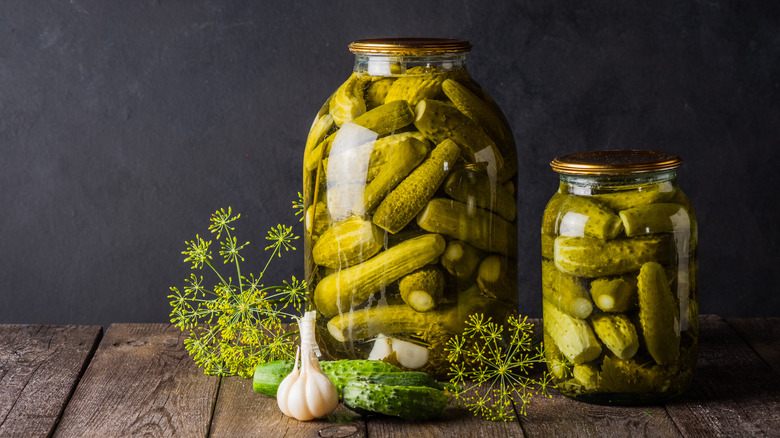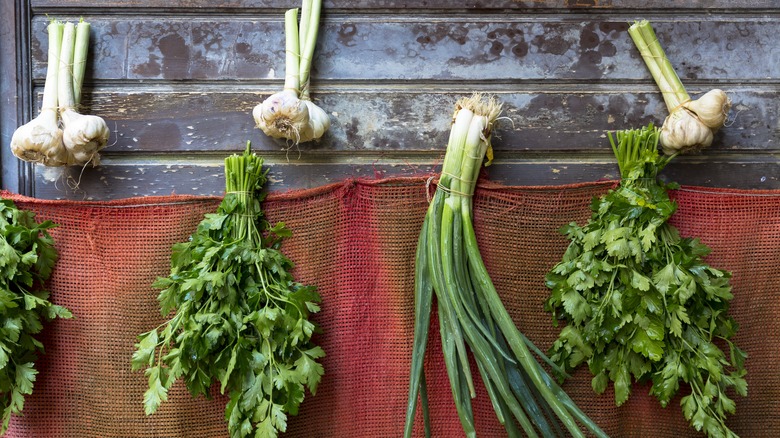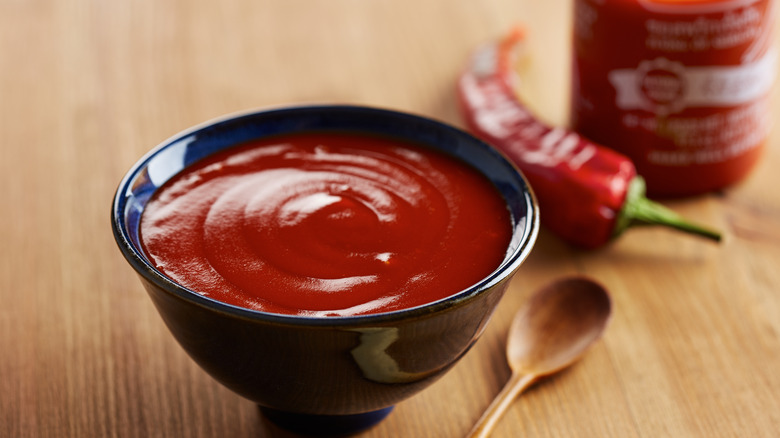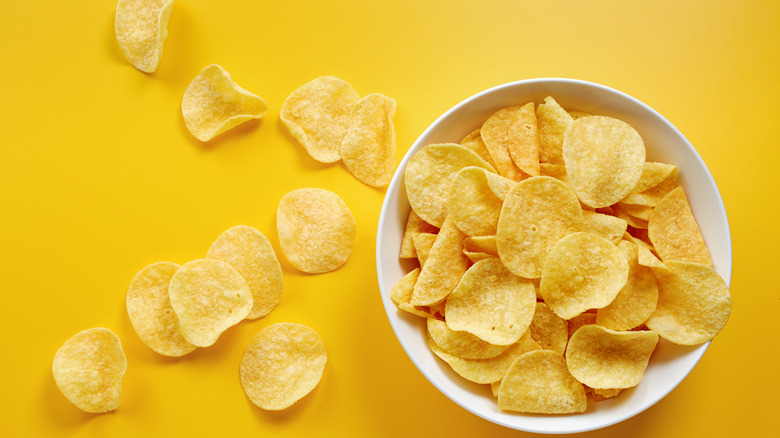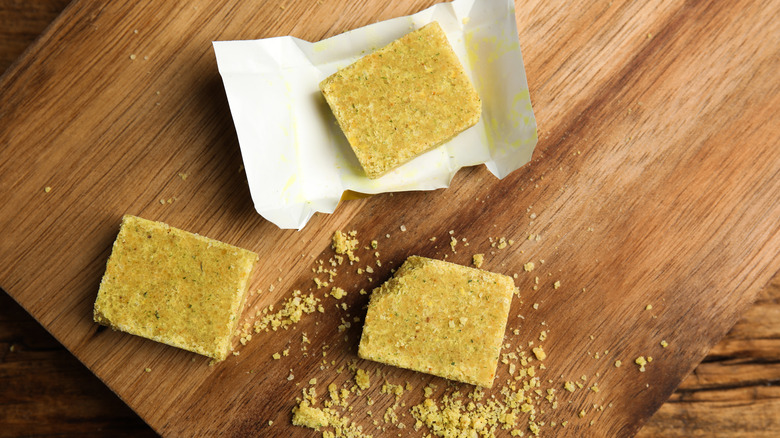14 Ways To Amp Up The Flavor In Potato Salad
If you have yet to master a potato salad recipe, you probably dread making this salad for potlucks and cookouts. There's a good chance that you're wary of potato salad even when someone else brings it. The truth is that most potato salad recipes are just okay, some potato salad recipes are really good, and too many potato salad recipes are really quite bad.
If you associate this summertime staple with pale, lumpy goop schlepped out of a plastic grocery store container, you're unfortunate enough to have likely only experienced some of the worse renditions of potato salad.
Hope is not entirely lost for potato salad or the cooks out there determined to make it enjoyable. There are a lot of ways to make an incredible potato salad, from wielding spices for an unexpected zing to jazzing up the ingredient list with some fresh veggies. There are numerous suggestions that can help bring flavor flair to this plain Jane salad.
1. Use russet potatoes
If you've ever felt like your potato salad is missing something, but you can't quite put your finger on it, you might not be using the optimal type of potato. Sure, in last-minute scenarios, you might be stuck with whatever is on hand. But if you can help it, pick your potatoes wisely.
The starch level of the tubers you select can help or hurt your salad, depending on the style of the salad and how you prepare it. Low-starch potatoes, such as fingerlings, new potatoes, and red potatoes, hold up well against overcooking and mushiness. These types of potatoes do bode well in some styles of potato salad, such as German potato salad, a warm salad that needs potatoes with plenty of structure.
However, when making a classic American potato salad, starchy taters like russets or Idaho potatoes could be the better way to go. After all, the types of potato that typically go into most commercial American potato salads can bring a pleasant creamy texture to the salad as long as they are prepared correctly. Just be more mindful of overcooking and stop the boil right at, if not just before, fork-tenderness.
2. Use instant potato flakes to help with the consistency
Texture is very important to foods. Even if the potato salad has a mind-blowing taste, an out-of-whack texture can totally ruin it. Turns out this can be solved with the addition of one simple ingredient, and it's something that you probably already have in your cupboards. DIY Ways suggests the addition of instant mashed potato flakes when it seems like your potato salad isn't going right.
Why would instant potato flakes make a difference? This ingredient reportedly helps bind the dressing to the potatoes. The potato flakes (you only need two tablespoons for a single batch of potato salad) are added at the end after your salad is otherwise complete. Make sure you thoroughly mix the potato flakes in to incorporate them all throughout the potato salad but do it gently so that you don't break your potatoes up too much.
3. Add a splash of vinegar for some tanginess
So you're plagued with a potato salad that's always dull and just ... missing something. Maybe it seems like everything else in the salad is overrun with the taste of mayo. If your potato salad is lame, you might just be missing the tang, and the quickest way to jolt that flavor is by including some vinegar in your recipe.
The acidic taste of vinegar helps balance other components of the salad without causing it to be bitter. Vinegar may help prevent your potatoes from drying out, too. You can use whatever vinegar is available to you, or many renowned chefs have their own recommendations. Alton Brown suggests using apple cider vinegar, according to his recipe on The Food Network, while Martha Stewart prefers white wine vinegar.
Red wine vinegar or balsamic vinegar could bring unique flavors to your potato salad, too. You can always experiment with different kinds of vinegar until you find what suits your tastebuds. Just be careful not to go overboard on this ingredient, as too much will tip the taste of your salad to sour.
4. Grill or roast your potatoes for a unique flavor
Flavortown natives say that one way to boost the appeal of your potato salad is by going outside of the box with your potato prep. Boiling may be the default cooking method for potatoes, but it isn't the only way. Guy Fieri actually recommends seasoning the potatoes with salt, pepper, and paprika, then laying them out on the grill in his Food Network potato salad recipe. This certainly adds more flavor interest to the most important component of potato salad, and you can ramp up the taste even more by using a smoker.
Boiling doesn't do much for potatoes in either the taste or texture departments, although if you are really set on boiling them, you can do so in chicken stock (or your preferred stock) rather than water to introduce some flavor complexity. Even if grilling isn't an option for you, roasting your potatoes can also help improve flavor and texture. Roasted potatoes tend to have a crispier exterior and a smooth, creamy inside, which can greatly improve the overall taste of a potato salad.
5. Sprinkle on some fresh cheese or nuts
So this suggestion might not be the right one for American potato salads since the mayonnaise-based ones are typically served chilled, but if you're venturing into other types of potato salads with different bases or the ones that are served hot, you'll want to also explore toppings beyond paprika and chives. Giada de Laurentiis uses gorgonzola cheese and chopped toasted walnuts to bring extra crunch and flavor to potato salad in her Food Network recipe.
You could also use blue cheese or sunflower seeds to add a pop of rich flavor to your potato salad. Or, if you're sticking with the more traditional American version of the dish, a simple sharp cheddar would do the trick, too. Cheese is easy to smoothly integrate into potato salad, but while nuts certainly may be more tricky, finding the right addition to your salad, whether it be walnuts, pistachios, or almonds, can change your potato salad game forever.
6. Use bacon or pancetta for a savory flavor
The savory saltiness of fatty pork can transform a potato salad that's lacking in the flavor department. We recommend using authentic, freshly-fried crumbles of bacon or pancetta (no store-bought bits, if you can help it) to get the full impact of the meat's flavor. Be sure to cook it until it's plenty crispy, and make sure the crumbles are consistently small and uniformly sized for the best texture in the potato salad.
While there's a lot of room for experimentation in adding either of these meats to different potato salad recipes, speaking from experience, pancetta may fare much better in warm salads rather than cold dishes. On the other hand, bacon could be used in either warm or chilled potato salads. Pancetta is nicely complimented by lemon, black pepper, and rosemary, while bacon is delicious in potato salads with added cheddar, paprika, and basil.
7. Add a bit of lemon zest to counteract bitterness
It's perplexing and frustrating when the first sample of a new potato salad batch is surprisingly bitter, especially when you've purchased the salad from the supermarket and have no way of knowing what ingredient is the culprit. One possible cause of an overly-bitter potato salad is too much vinegar, and that can easily be solved with the zest of a lemon as the acidic nature of the zest dampens the vinegar's potency and adds a lightness to the salad.
Simply add roughly a half teaspoon of zest per every two cups of potato salad: That's about the equivalent of about a couple of passes of your microplane or zester. There are a couple of other solutions to a potato salad that has too much vinegar. If you don't have a lemon on hand, try adding sugar or baking soda, starting in very small amounts and working up to the taste you prefer. More potatoes can also even out the distribution of the vinegar.
8. Use finely-chopped veggies for a bright freshness
Don't hesitate to enlist the help of other vegetables if your potato salad is underperforming. This is a great way to dress up a boring store-bought potato salad, too. The best veggies to add will vary based on your style of salad.
Celery adds a classic flavor and crunch to cold potato salads, but chopped radishes would do the same with a more novel, garden-fresh feel. If you're aiming for a lighter, more refreshing potato salad, try adding cucumber instead. Red onions are almost always a good idea, too: Just go light and chop small to distribute a distinctive but unoffensive onion flavor.
Here are a few other veggie additions you may want to consider to add some color and flavor variety to your potato salad: Red bell peppers, carrots, scallions, roasted zucchini or squash, asparagus, grape tomatoes, or green beans. If you're going for a more Southwest-influenced salad, try adding golden sweet corn.
9. Add paprika for a sweet smokiness
We're glad to see paprika gaining popularity in cooking: This spice, made from dried and ground sweet red peppers, deserves so much more attention than a dusting on deviled eggs. A lot of recipes already call for the use of this spice, but you may be doing your potato salad an injustice even if you're following the recipe and using regular paprika. Consider splitting up the required amount of paprika with smoked paprika, which will add an intriguing smokiness to your salad, as well as sweet paprika, which will add some extra variety of flavor.
Some chefs say that the way you know an ingredient is being used correctly is when you can't taste it, but if you really can't tell that the paprika is there at all, try adding more than the recipe calls for in minuscule increments until you achieve the desired taste. Just heed our warning: Once you start using sweet and smoked paprika, you'll never want to touch the regular stuff again!
10. Pick the right pickles
Pickles and relish have a lot to offer potato salads. Their vinegary twang and crunch are valuable features. Pickles are usually also full of the flavors of the spices and seasonings that they've been marinating in. Both pickles and relishes can be added to a potato salad to liven up its flavor, but be mindful of which type you reach for. Anything pickled that's heavy on the dill seasoning will bode well in a classic American potato salad, but using sweet pickles will create a more standout taste.
Small amounts of pickle relish will go way further than cut pickles. Feel free to explore by using different homemade and store-bought relishes that may incorporate different ingredients, like peppers, garlic, ginger, or onions. If you're going off-script of a recipe to add the relish, start with small amounts: Maybe two tablespoons at a time, and work your way up to the desired tanginess. If a recipe does call for relish and your guests aren't pickle fanatics, try halving the quantity of the relish, taste the salad, and add more as desired.
11. Incorporate fresh herbs
Fresh herbs are one of the most powerful secret weapons when it comes to making a potato salad that everyone will love. A few sprigs of dill is a pretty classic and safe way to brighten things up, but a couple of fresh basil leaves will add an unexpected twist, too. You can use purple basil if you're looking for an especially bold flavor and a striking violet color, but you don't have to stop there. Lemongrass, chives, parsley, and rosemary can also be incorporated into a potato salad, depending on which other elements you're including.
We've also found that a small handful of microgreens added to potato salad will pack a powerful punch. You'll want to start small with some of the more peppery microgreens, like radish and arugula, since these sharp flavors can become overpowering very quickly. But whether you're using fresh herbs or microgreens, a safe way to adapt these ingredients for your potato salad is to leave it out of the actual recipe and top your serving with it instead. This way, you can taste ztest and tweak the salad without risking the entire batch (and the approval of your guests).
12. Don't be afraid to spice it up
Is it getting hot in here, or is it just the potato salad? You don't have to add a nose-running, mouth-fanning level of heat, but there's nothing wrong with including a spicy flair that'll put just a little tingle in the back of the throat. We've suggested prepared horseradish for spicing up your potato salad before, but if you want to be more forward with the spice delivery, try sriracha (or your preferred hot sauce), chili powder, or pickled jalapeño.
To stick to a very subtle heat, hot paprika, which is made with a slightly spicier variety of pepper, can do the trick. Or, if you want to start very small or are unsure of your guests' spice tolerance, just add a few cracks of freshly ground black pepper or a sprinkle or two of red chili flakes. You can go for a full-blown Southwest-themed salad and add hot sauce, sweet corn, chipotle powder, cilantro, and lime juice. It's outside of the box but so delicious!
13. Potato chips bring the crunchy goodness
Between the cooked potatoes and that dense mayonnaise dressing, the texture of potato salad can feel sodden and unpleasant. A fun way to combat this is by adding more potatoes in a different form. If you feel like your potato salad needs a textural makeover, crush up some potato chips into semi-fine pieces (you don't want to create a powder since that would defeat the purpose) and add them to the salad.
The catch with this ingredient is that potato chips will absorb the liquid dressing and become soggy if they're mixed in at the wrong time. You should do this right before serving, and only add to the amount of salad that you're confident will get eaten immediately. If you anticipate a lot of leftovers, reserve some of the salad to add potato chips later. You could also top the salad with crushed chips instead of mixing them in and experiment with sour cream and onion or barbecue-flavored potato chips if you're feeling adventurous.
14. Chicken powder is the ultimate secret weapon
If you want your friends and family to beg for your potato salad recipe, use this secret ingredient. Chicken stock/bouillon powder is an understated but powerful way to round out the flavor of countless dishes. The specific seasonings vary by brand, but most chicken powder includes spices like turmeric and parsley, plus dehydrated vegetables and possibly MSG, all of which contribute to a more complex and diversified taste.
There are two ways that you can apply chicken bouillon to potato salad. We opt for the more subtle method, which is to add the bouillon cubes or powder to the water that your potatoes boil in. Since those starchy tubers suck up tons of moisture while cooking, they'll retain all that flavor.
You can also add the powder directly to your salad, but this may take some trial and error as the seasonings in the powder may clash with existing spices in your recipe. You'll also want to figure out the right amount for the flavor intensity you desire. Of course, if you'd like the salad to be vegetarian, you can also opt for a veggie or imitation chicken stock instead.
